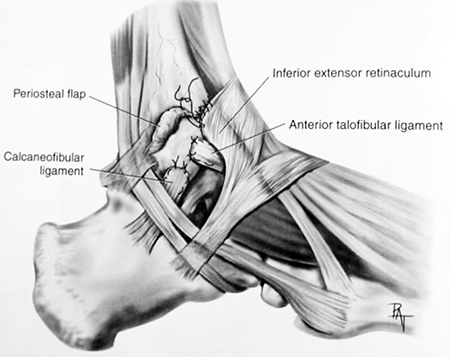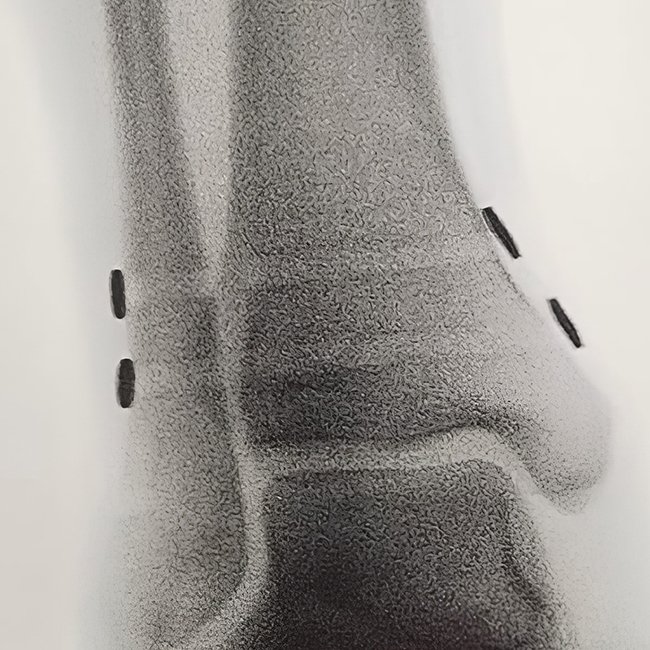Ankle Ligament Surgery at Norwest Private Hospital Sydney
Ankle Ligament Surgery to stabilize the ankle joint.
Ankle ligaments provide support and stability to the ankle joint. Over time, the ligaments can become damaged due to repeated sprains, trauma, or overuse.
Loose ligaments usually manifest with an ankle joint that feels unstable, does not support the weight of the body well, or is easily sprained on use.
Ankle ligament surgery aims to restore the supportive and stability functions of the ankle ligaments.
Illustration showing lateral ligament reconstruction.
What is Ankle Ligament surgery?
Ankle ligament surgery is used to treat and manage ankle sprains, ankle trauma, ankle ligament damage, and ankle instability where non-surgical methods have not had the desired effect in reducing symptoms. Patients may choose to undergo ankle ligament surgery for their loose, easily sprained ankles that may be causing posture issues or other instabilities of the foot.
How is Ankle Ligament Surgery Performed?
Arthroscopy is used in combination to open surgery to perform ankle ligament surgery. Arthroscopy is a minimally invasive technique that uses precise tube-like surgical instruments called arthroscopes. The use of arthroscopy allows the orthopaedic specialist surgeon to complete the surgery with small incisions (cut) on the ankle. From there, the orthopaedic specialist surgeon is about to locate the damaged tissue of the ligament and make repairs with stitches to the bone, often done openly.
What are some risks and complications of Ankle Ligament surgery?
Before undergoing any surgery, an orthopaedic specialist surgeon will discuss risks and potential complications with you and answer any questions you might have.
Some risks include:
Wound infection: this occurs in less than 1% of all procedures and can be treated with antibiotics
Nerve damage: there is a small risk to losing sensation of the skin in area surrounding the surgical site, but this is very rare.
Blood clots: with any surgical procedure, there is a small risk of the blood clotting in the vessels causing pain and swelling. If you have known risk factors associated blood clots, the specialist may prescribe you with some blood-thinners during the recovery period. The risks are present but small (3% or less). If you experience abnormal swelling and pain of the leg, please contact the specialist urgently.
Instability: The risks of having further instability after surgery is low and below 5% recurrence. You can further reduce the risks by physiotherapy exercises.
How much does it cost to have Ankle Ligament surgery?
The costs to have Ankle Ligament surgery in Sydney depends on each individual treatment plan. Costs will depend on the treatment outcomes and complexity of the case presented. We provide full costs disclosure before initiating any treatments and therapies.
We accept most major private health insurance funding, and our knowledgeable staff can assist you with the health insurance claims process, but it is always helpful to contact your provider in advance to ensure that your insurance covers the orthopaedic procedure.
In most cases, you may be expected to pay a gap fee, but this is dependent on the cover of your private health insurance.
Associate Professor Roderick Kuo works only in the private health system and unfortunately does not maintain a public system list. However, some conditions may be treated with non-surgical methods such as physiotherapy that can be initiated after a consultation and review of your circumstances.
Here’s what to do next…
Research your condition and treatment options
We provide extensive information about Ankle Sprains on our conditions page.
Read our FAQ about Ankle Ligament Surgery below.
Do further research and contact us with any questions you may have.
Book a consultation with Associate Professor Roderick Kuo
Prior to your appointment, please obtain a referral from your General Practitioner. This will allow you to claim a Medicare rebate on the consultation fees.
Call or email our team at Specialty Orthopaedics to book your consultation.
Frequently Asked Questions about Ankle Ligament surgery?
-
Because it is a minimally invasive procedure, arthroscopy is usually done as a day surgery procedure meaning it should only require you to be in hospital for less than 24 hours.
-
Prior to surgery, you will be given general anaesthesia and a local injection around the ankle area, so you remain pain-free during and after the surgery. During the recovery period, you may be prescribed some stronger painkillers to reduce any discomforts.
-
After the surgery is complete, a boot / brace will be applied and will remain in place for 6 weeks after surgery and is needed to ensure the ankle joint stays in place while it is healing. Afterwards you will be sent to the recovery unit and monitored for a period of time to allow the general anaesthesia to wear off and your body vitals to normalise. It is important at this time to report any discomfort, pain, or nausea you may have to the doctors as they can assess your need for painkillers or anti-nausea drugs when you are discharged.
You will be referred to a physiotherapist who will start you on a recovery programme. It is recommended that you follow the guidance of the physiotherapy programme as it will speed up your recovery drastically and allow you to get back on your feet sooner.
If you are well, you should be discharged from hospital on the same day.
-
In the first week after the surgery, you should attempt to minimalize moving around unless necessary. This is to ensure the ankle joint is kept in place while healing. Weight-bearing on the foot is allowed in most cases and crutches occasionally required.
Attempt to elevate your foot to the level of your heart to reduce swelling and take painkillers whenever you experience pain.
You may find some blood ooze at the site of the surgery which is normal. However, if you notice bleeding does not stop, please contact the orthopaedic specialist surgeon urgently.
-
You can weight bear as tolerated in the boot / brace for 6 weeks after surgery, in most cases. Occasionally you may use crutches to move around.
Around six weeks after the surgery, you should regain weight-bearing ability of your foot without the need of the boot / brace, but this is different for each individual and you should consult your orthopaedic specialist surgeon before removing the boot / brace.
-
Healing and recovery times are different for each individual person. In general, you should be able to return to work in 2 weeks if you mostly sit at work. You should allow for 8 to 12 weeks to recover if your work involves manual labour.
-
The typical follow-up appoints after you have been discharged is as following:
10-14 days after surgery
At the first appointment, orthopaedic specialist surgeon who will remove your brace / boot and examine your wound and ankle and sutures are removed. At this appointment, be sure to discuss any pain and discomforts you may be experience.
Six weeks after surgery
The boot will be removed at this appointment and you will start physiotherapy. You will be able to wear normal shoes.
Twelve weeks after surgery
This is the final appointment you will have with the orthopaedic specialist surgeon. A final examination of your ankle will be performed and if all is well, you will be discharged.
Important: Information is provided for guidance only. Individual circumstances may differ and the best way to approach a condition is by individual medical consultation where a specialist can tailor a treatment plan to suit your needs.
Edited by Dr Roderick Kuo
Last updated: 5/5/24






